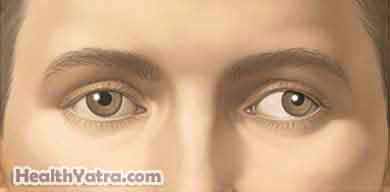Definition
Strabismus is a problem with the alignment of the eyes. One or both of the eyes are turned in, out, up, or down. Strabismus is most common in children but may occur in adults. It can lead to permanent vision loss if it is not detected and treated in a timely manner.

There are two types:
- Constant strabismus—the eye turns all the time
- Intermittent strabismus—the eye turns only some of the time, like in times of stress, illness, concentration, or when tired
Causes
Strabismus is caused by a lack of coordination between the muscles in the eyes. This can happen due to:
- Problems, imbalances, or injuries of the muscles that move the eyes
- Glasses are needed but not used
- Nervous system disorders that affect vision, such as:
- Problems or injury of the nerves that control the eye muscles
- Tumor in or near the eye or brain
- Strokes or bleeding in the brain
- Increased pressure in the brain
- Myasthenia gravis
- Hormone problems, such as:
- Diabetes
- Thyroid disease
- Vision loss in one eye—the blind eye will often turn in or out
Risk Factors
Factors that increase your risk for strabismus include having:
- Family member with strabismus
- Diabetes
- High blood pressure
- Retinopathy of prematurity
Symptoms
Symptoms may include:
- Double vision
- Crossed eyes
- Eyes that do not align properly
- Uncoordinated eye movements
- Squinting
- Favoring a certain head position
Diagnosis
The doctor will ask about your symptoms and medical history. A physical exam will be done. You should also have an eye exam by an ophthalmologist. This specialist will test your eyesight and look for other potential eye problems. You may also be given a neurologic exam and other tests to rule out other possible causes.
Treatment
Treatment may include:
Glasses
Glasses or contact lenses may be prescribed. They can improve your ability to focus and help overcome poor vision. With better eyesight, strabismus may improve. For some conditions, special prism lenses can be placed in the glasses. The prism will help to reduce double vision that may occur.
Patching
In children, an eye that is not properly aligned may not mature properly. If this is not corrected, permanent visual loss can occur. In some cases, a patch is applied over the good eye. This forces the child to fixate and use the affected eye. This will help the visual development in that eye. The length of time the patch is worn depends on the severity of the condition and the age of the child.
Medication
Eye drops or ointment may be put in the good eye to temporarily blur the vision. This also forces the affected eye to fixate properly. These drops may be used as a substitute for patching.
In rare cases, injections of botulinum toxin may also be used to treat strabismus. They affect the muscles surrounding the eyes.
Surgery
Surgery may be used to straighten the eyes if nonsurgical means are not successful. The surgery will move some of the eye muscles into a new location. This may improve the ability of the eye muscles to keep the eyeball in its proper place.
Prevention
There is no known way to prevent strabismus. If you notice that you or your child’s eyes are not properly aligned, visit your eye doctor immediately.
